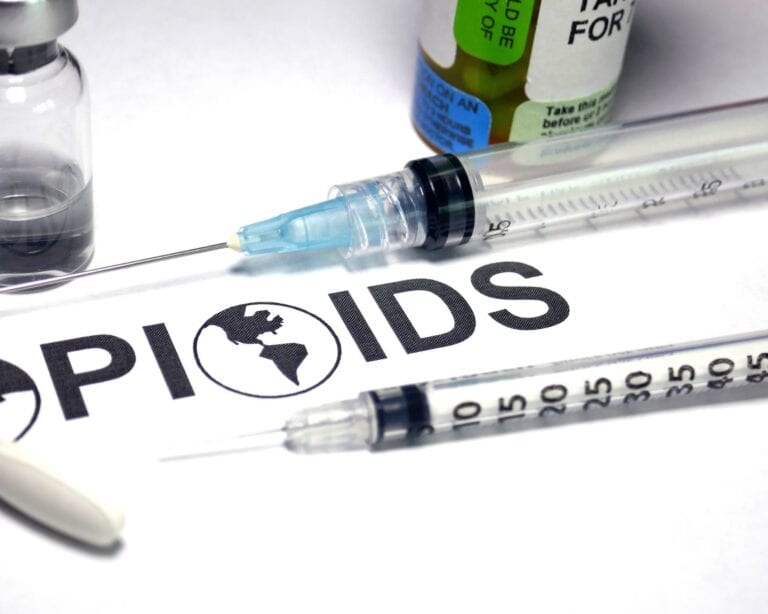Prescription opioids are a group of drugs prescribed by physicians to help manage pain. There are many different types of opioids, such as hydrocodone (Vicodin), oxycodone (Percocet, OxyContin), morphine, and methadone. Some opioids are stronger than others, but all produce similar side effects. Another characteristic all prescription opioids have in common is their potential for diversion, abuse, and addiction.
Since the late 1990s, rates of opioid abuse and addiction have continued to increase. In 2019 alone, more than 70,000 people died from opioid overdose and more than 1.6 million were thought to struggle with opioid use disorder.[1] While proper treatment for prescription opioid addiction can be successful, it is often difficult to get individuals to agree to get help. In the end, it is left up to family members and friends to convince their loved ones to go to rehab. As a result, it’s important to be able to spot when a person is abusing or addicted to prescription opioids.
Here are 4 signs of prescription opioid abuse and addiction.
1. Pinpoint Pupils, Flushed Skin, Nodding Off, and Other Physical Symptoms of Opioid Abuse
Sometimes, the easiest way to spot opioid abuse is to look for the physical signs. Opioids are central nervous system (CNS) depressants, which means they slow down bodily functions and cause feelings of relaxation or calmness. People who are under the influence of opioids may seem tired, drowsy, or even begin “nodding off” – a term used to describe opioid users who drift in and out of a state of consciousness.
Another easily identifiable sign of opioid intoxication is pinpoint pupils. When people are high on opioids, their pupils become constricted.[2]
This may be especially noticeable in people with blue or green eyes because much more of their Iris is exposed.
Other physical symptoms produced by opioids include:
- Loss of coordination
- Nausea or vomiting
- Constipation
- Flushed or pale skin
- Slow or shallow breathing
- Itching of the face or arms
People who exhibit these physical symptoms on a regular or frequent basis may be struggling with prescription opioid addiction.

2. Doctor Shopping – Because One Opioid Prescription Is Never Enough
Addiction is often defined as a disease of “more.” Whether a person is addicted to alcohol, opioids, shopping, or food, they always want more of whatever it is they are addicted to. If a person is addicted to prescription opioids, they may engage in a risky and illegal act called doctor shopping to maintain a steady supply of their drugs.
Doctor shopping is when a person visits multiple doctors, often across state or county lines, without telling each doctor about the other one. They do so in hopes of obtaining multiple opioid prescriptions to hold them over until their next refill. And, when their doctors no longer agree to refill their medications, these individuals often turn to the streets to buy their drugs illegally.
Overall, between 21-29% of patients who are prescribed opioids for pain abuse them – and 80% of people who are addicted to heroin first started using prescription opioids.[3]

3. Inability to Function Without Opioids, Withdrawal Symptoms
People can develop a physical dependence on some opioids in as little as 7 days. Regardless of what type of prescription opioid is being abused, all are habit-forming and can cause withdrawal symptoms when stopped abruptly.
Many people who suffer from prescription opioid addiction continue using opioids simply to avoid going into withdrawal. They find it difficult to function on a day-to-day basis without their drug. And, when they try to stop using, they suffer painful, flu-like withdrawal symptoms, such as:[3]
- Muscle aches
- Restlessness
- Anxiety
- Runny eyes and nose
- Sweating
- Cold chills
- Difficulty sleeping
- Excessive yawning
- Diarrhea
- Abdominal cramping
- Nausea and vomiting
- Dilated pupils
- Rapid heartbeat
- High blood pressure
- Drug cravings
While these symptoms are generally not life-threatening, they can be extremely uncomfortable without medical assistance.
4. Behavioral Changes and Obsession With Opioid Drugs
Another way to spot prescription opioid abuse and addiction is to look at an individual’s behaviors. Individuals struggling with addiction may experience mood swings, changes in their sleeping and eating patterns, and issues with their memory.
Other common behavioral signs of prescription opioid addiction include:
- Lying to friends and family about whereabouts, substance use, and more
- Isolating from friends and family members
- Stealing or going to extreme lengths to obtain substances
- Getting into trouble with the law such as driving under the influence
- Going through one’s friend’s and family’s medicine cabinet searching for opioids
- Spending a lot of time obtaining, using, and recovering from the effects of opioids
- Neglecting one’s responsibilities
- Losing interest in activities that were once enjoyed
When confronted about their substance abuse, addicted individuals may become hostile, angry, and even aggressive. They may persistently deny having a problem with their opioid medications. All of these behavioral changes are tell-tale signs of addiction.

Get The Care You Need and Deserve
Woburn Addiction Treatment is a leader in the addiction treatment field, with proven success in facilitating long-term recovery. Our team of top clinical & medical experts specializes in treating addiction coupled with mental illness, ensuring that each person receives individualized care. Call us – we’re available 24/day, 7 days/week.
Treatment for Prescription Opioid Addiction in the Boston, Massachusetts Area
Overcoming opioid addiction isn’t easy, but with the right help, it is entirely possible. If you or someone you love has been suffering at the hands of opioid abuse we’re here to help. Our comprehensive and highly individualized opioid rehab program in Woburn, MA is unlike any other in the area. Not only does our opioid rehab program have a completion rate 150 percent higher than the national average, but our team of experienced clinical professionals has developed an integrated program that focuses on 12-step immersion, intensive therapeutic intervention, a holistic approach to wellness, and thorough aftercare planning. Contact us today to get started.
References:


